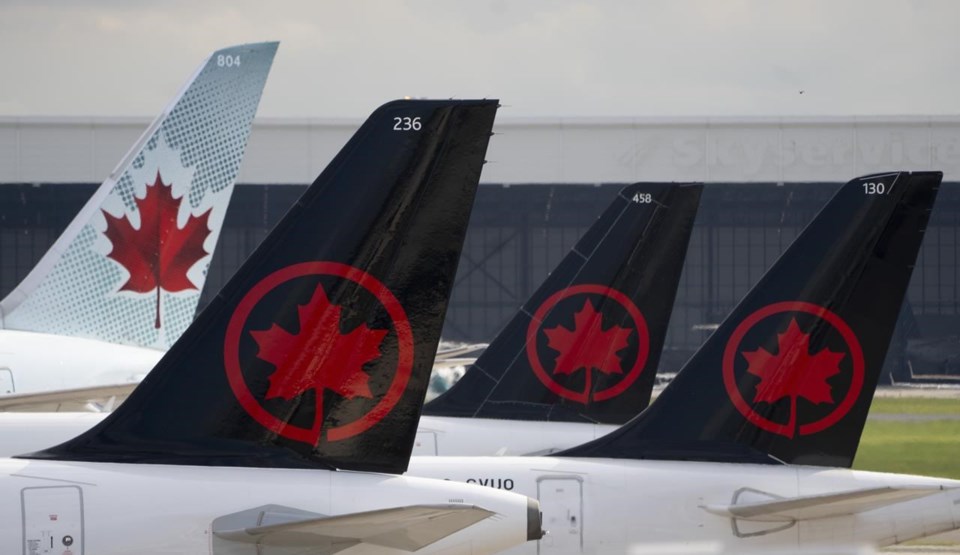MONTREAL — Air Canada is proceeding more cautiously on growth plans this year, despite sturdy profits and strong bookings last quarter as its post-pandemic recovery continues.
The country's biggest airline aims to boost flight capacity by six per cent to eight per cent, below analysts' expectations of a 10 per cent increase.
"This is reasonable for us as we continue to see industry supply chain pressures and other constraining factors," said head of network planning Mark Galardo on a conference call with analysts Friday. Those pressures may include production delays at Boeing Co. and Airbus SE, with at least one Air Canada plane delivery this year pushed back to 2025.
The carrier's brake tapping means it won't exceed 2019 capacity levels until 2025, five years after the COVID-19 pandemic first hammered the travel industry.
The slowdown also suggests the "rapid expansion in leisure routes may be scaling back," said RBC Capital Markets analyst Walter Spracklin. And it stands "in contrast" to plans by other large airlines in North America, according to Savanthi Syth of Raymond James.
Air Canada shares fell $1.26 or nearly seven per cent Friday to close at $18.00 on the Toronto Stock Exchange.
Nonetheless, short-term demand remains steady, with advance bookings up six per cent year-over-year in the fourth quarter. Air Canada earned nearly 10 per cent higher year-over-year profits even as it strained to keep a lid on cost increases that have plagued the industry.
More flights and higher fares on international trips — particularly over the Atlantic and Pacific oceans — drove a 12 per cent rise in passenger revenues last quarter versus a year earlier, said CEO Michael Rousseau.
He called the full year "very successful," as net income over 12 months swung to a profit of $2.28 billion from a $1.70-billion loss in 2022.
Adjusted earnings of $521 million in the fourth quarter marked a 34 per cent jump, though that figure fell below consensus expectations of $548 million, according to financial markets data firm Refinitiv.
Some of that shortfall stemmed from a 21 per cent increase in quarterly labour costs that arose from employing 3,200 more workers as of Dec. 31 than at the start of the year, as well as from "wage inflation" and profit sharing, said chief financial officer John Di Bert.
Greater costs comprise much of the uncertainty facing Air Canada this year.
A new agreement with its nearly 5,300 pilots now under negotiation is poised to hike wages by a yet-to-be determined amount. Customer compensation rules currently being drafted are also among the "net headwinds" set to blow against profit margins, as are likely hikes to airport fees, Di Bert said.
Air Canada forecast a rise of 2.5 per cent to 4.5 per cent in cost per available seat mile — a key metric that gauges efficiency — following a 4.1 per cent increase last year.
"Costs are coming in notably higher than what had been expected previously," Spracklin said.
In spite of softer growth plans, the company boosted its adjusted earnings outlook for 2024 to between $3.7 billion and $4.2 billion from $3.5 billion to $4 billion previously. That means profits will hinge even more on pricier fares, "which we see at risk," Spracklin said.
Competition is another area to watch, as Porter Airlines, Flair Airlines and Lynx Air strive to carry out ambitious expansions.
"However, press reports this week have suggested that Flair and Lynx — both of which we suspect are financially struggling — may be in merger talks," said National Bank analyst Cameron Doerksen.
An acquisition would likely reduce growth in the discount air travel market, Doerksen said. That would be welcome news for "increasingly concerned" investors in Air Canada, which already goes head-to-head with Flair and Lynx on routes amounting to 28 per cent of its domestic capacity this quarter, he added.
On the labour front, aviators at Delta Air Lines, United Airlines, American Airlines and Southwest Airlines secured agreements last year that included four-to-five-year pay hikes ranging from 34 per cent to 50 per cent.
Up to 500 Air Canada pilots are working with U.S. immigration firms in search of a better contract, according to the Air Line Pilots Association, which represents them.
The union, whose decade-long collective agreement expired in September 2023, entered into private mediation with the carrier last month.
"We look forward to sharing in the company’s success,” said Charlene Hudy, who heads the union's Air Canada contingent, noting the potential leverage of a global pilot shortage.
On Friday, Air Canada reported that net income rose to $184 million in the airline's fourth quarter from $168 million a year earlier.
Operating revenue rose 11 per cent to $5.18 billion in the three months ended Dec. 31 from $4.68 billion in the same period in 2022.
Fourth-quarter operating capacity increased nine per cent compared with the year before, the Montreal-based company said.
Operating expenses jumped eight per cent due partly to higher costs that reflected the greater traffic, somewhat offset by lower jet fuel prices.
On an adjusted basis, Air Canada lost 12 cents per diluted share in its latest quarter, compared with an adjusted loss of 61 cents per diluted share a year earlier.
The result notched below analyst expectations of an adjusted loss of four cents per share, according to Refinitiv.
This report by The Canadian Press was first published Feb. 16, 2024.
Companies in this story: (TSX:AC)
Christopher Reynolds, The Canadian Press



